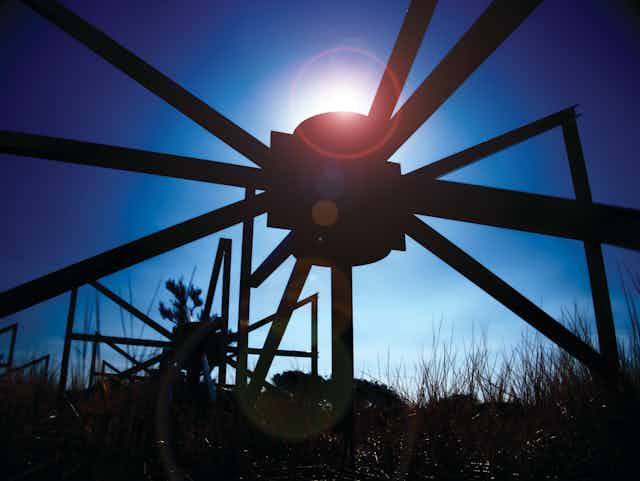It has been my privilege over the last six years to work on a project that combines an Indigenous Australian perspective of the universe with astrophysics. This has led to an astonishing series of global art exhibitions and opened a dialogue that has promoted the principle of reconciliation between Indigenous and non-Indigenous Australians.
The culture of Indigenous Australia is tied to country, a connection to ancient knowledge, tradition, and spirituality. Less well known, perhaps, to non-Indigenous Australians is the connection to the night sky that also runs deep in Indigenous culture.
The night sky is part of the shared heritage of all people on Earth. Every culture derives a different meaning from our common wonder at the mysteries of the universe. Indigenous Australians have carried this meaning within their culture for tens of thousands of years.
Astrophysics provides a scientific interpretation of the universe – and one of the major future tools for astrophysics research is the Square Kilometre Array (SKA), a massive telescope to be built on the traditional lands of the Wadjarri Yamatji people in the remote Murchison Shire of Western Australia.

The SKA will look back in time to the origin of the first stars and galaxies, seeking answers to fundamental questions in physics.
Making a connection
In 2009, during the International Year of Astronomy, I started working with Indigenous artists from Yamaji Art in Geraldton, the largest town close to the SKA site. Katherine Moroz and Charmaine Green co-initiated the project with me.
Many of the artists are from the region in which my colleagues and I are building telescopes in advance of the SKA. Our goals were to explore Indigenous and western interpretations of the sky and discuss the telescopes taking form in the Wadjarri Yamatji country.
Indigenous artists and astrophysicists are two groups that would not normally interact. Nobody was quite sure what to expect. So, we took it slowly. In March 2009, we organised a visit to the SKA site.

On the 350-kilometre trip from Geraldton, we stopped in Mullewa. We invited the community of the small town to come out and look at the stars that night. For many of the artists, this was the first time they had looked through a telescope, for a close-up view of Saturn and clusters of stars such as the Jewel Box. It was a great way to break the ice.

From Mullewa, we moved on to the SKA site with accommodation at Boolardy Station. We had a chance to walk over country with elder Edward (Tedo) Ryan, a Wadjarri Yamatji man who was born at Boolardy Station. Tedo explained the relationship between the people and the land.

We were able to talk about the telescopes we were building on that land. Striking concepts started to emerge. The ancient land of the Wadjarri Yamatji forms a connection to the past, to ancestors, to traditions. The land is a way to look back into origins.
And the astronomers, building ultra-modern telescopes in this ancient landscape, were also looking for a connection to origins, by looking back in time to the beginning of the universe.
After a long day, as evening fell, the artists started plans for new works of art.
With no moon to brighten the clear skies, the Murchison night engulfed us. The stars and planets revealed themselves in a horizon-to-horizon panorama of the sort that can only be found in outback Australia.
Around the campfire, the group came alive: reservations fell away and stories about the stars flowed naturally.
We traded Indigenous and western stories. We learned about the different ways we view the same patterns in the sky, such as the Emu in the Sky that lies within the Milky Way. And we learned about striking similarities, such as the story of the Seven Jilas – which is known as the Seven Sisters (Pleaides) in western astronomy.

We journeyed home the next day, inspired by what we had experienced.
Indigenous art and astrophysics
The dozen artists who made the trip spread the word and, within the Yamaji Art community, more than 150 new pieces of art work were produced. Some pieces showed traditional stories, some were inspired by the science or looking through telescopes for the first time, and some were an interesting fusion of ideas.
The art was curated into an exhibition, called Ilgarijiri – Things Belonging to the Sky (you can see example pieces of art from the link), which opened at the Geraldton Regional Art Gallery in 2009; more than 500 people attended the opening – their biggest event ever.
The exhibition toured Perth, Canberra, Cape Town, and Washington DC during 2009 and 2010. The entire inventory was sold. The artists continued to refresh the artwork and the exhibition toured again, in Den Hague (the Netherlands), Berlin, and at the EU Parliament in Brussels, in 2012.

The exhibitions have exposed many thousands of people around the world to this fusion of science and ancient culture, the artists have achieved global sales of their art, and the artists and astronomers have formed a close relationship around the ongoing project.
The relationship between Indigenous and non-Indigenous cultures in Australia is a highly complex and charged issue, with a sad and tragic history. We all need to take steps toward reconciliation. Sometimes those steps are via unexpected channels – such as astrophysics and art.

